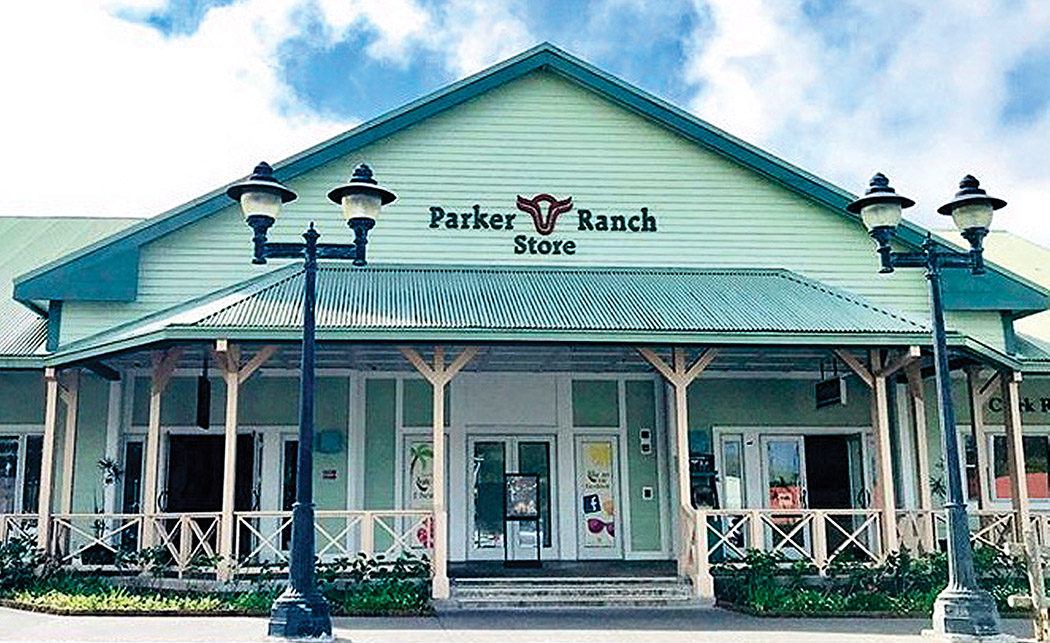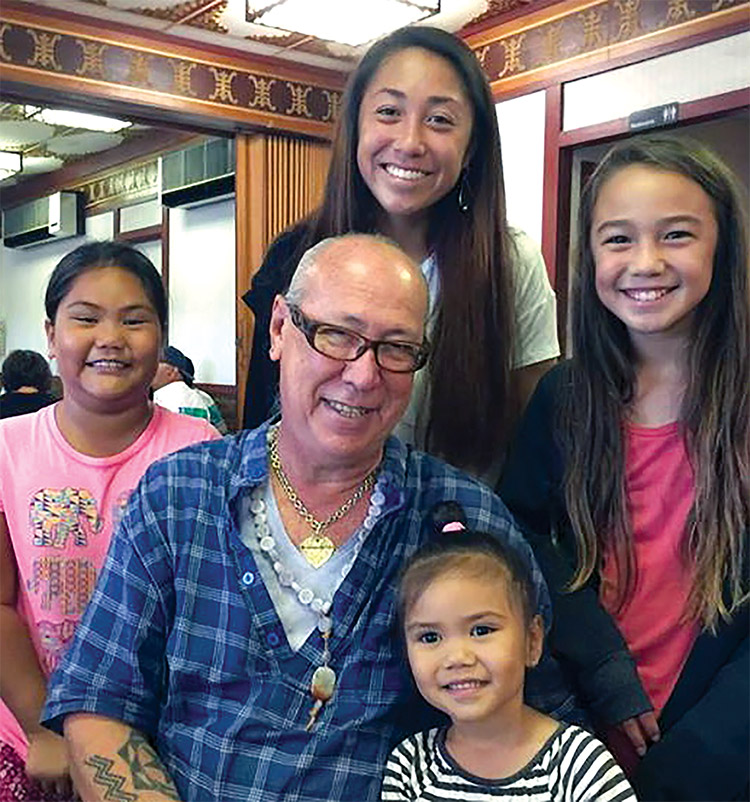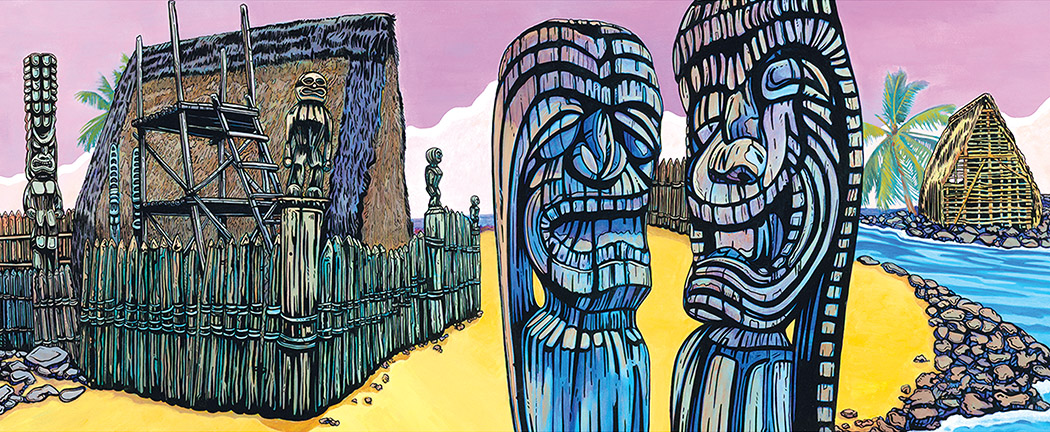
It’s Tiki Time! Three Island Artists Turning Idols into Art
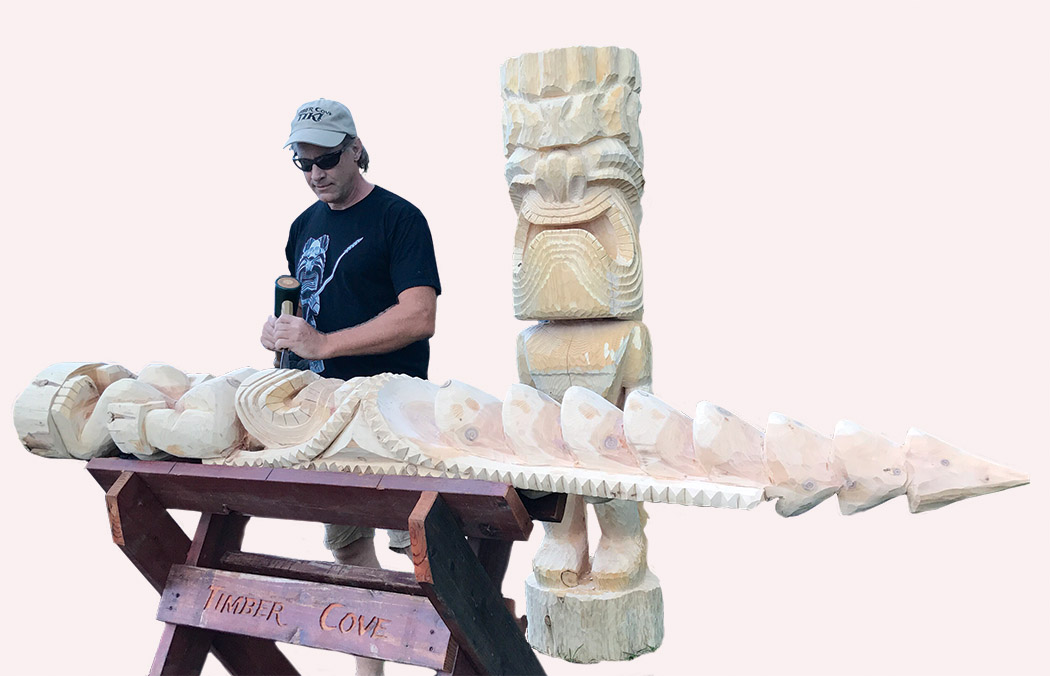
By Karen Rose
Romanticized images of Hawai‘i and Polynesia abound in Hollywood films and dramatizations of island life. One of the most iconic images of Hawai‘i adopted by popular culture is the tiki. Tikis are wooden carvings created to represent the image of a particular deity and to embody its particular power.
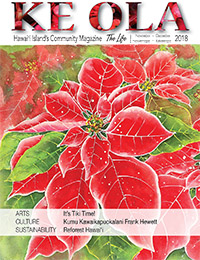
Contemporary tiki culture has drawn both criticism and praise. Visitors to Hawai‘i love to take home tiki memorabilia to remind them of their time spent relaxing in tropical paradise. Pacific Islanders have mostly taken this American fascination in stride, despite the sometimes-dubious reaction to seeing their ancient gods or ancestors on a coffee mug or in a bar.
Today’s obsession with tikis has moved beyond the tiki bars of the 1950s and made its way into the fine art realm. Three local artists on Hawai‘i Island have helped evolve this kitschy retro trend into a whole new level with their unique interpretations of these ancient, sacred carvings.
One such artist is Brad Parker of Kailua-Kona. Brad considers himself a “Tiki Artist” who specializes in Hawaiiana pop culture. He likes to think of his work as bringing the fine art of lowbrow and cartoon realism into the popular world of souvenir art.
“I started becoming interested in tiki art when I was a kid and I went to Disneyland for the first time, and visited the Enchanted Tiki Room,” says Brad. “Then in the 80s, I moved to California to go to art school. In the late 80s and early 90s, a whole subculture started to appear on the West Coast. It was a sort of revival, called urban archeology. A bunch of us would get together and go to tiki bars around LA and San Francisco. We’d wear retro aloha shirts, and we’d drink old-style drinks. It turned from a local, small underground scene into this kind of above board art movement and pop culture movement.”
The tiki craze hit its peak in the late 1950s when tiki-themed establishments were at a crescendo. Post-World War II Hawai‘i mania swept through the mainland with tiki-themed bars, drive-in theatres, motels, and restaurants incorporating the word ‘tiki’ into their names. The craze began to decline in the 60s and 70s.
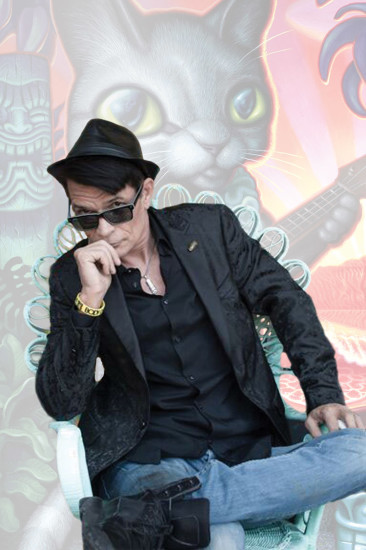
“The tiki culture kind of got swept under the carpet, when people began to recognize it wasn’t really a Hawaiian cultural thing at all,” says Brad. “Instead, this tiki culture was someone’s foggy memory of Hawaiian culture they recalled when traveling back through the Philippines and the South Pacific after World War II. What they remembered Hawai‘i was kind of like, but not exactly. Tiki art wasn’t really Hawaiian culture—it was pop Hawaiiana culture.”
As the tiki culture began to disappear, so did the hotels, restaurants and bars. Tiki enthusiasts began to venture out on urban archaeology tours to find old tiki-type establishments.
“It was kind of like finding lost civilizations that never really existed in the first place,” says Brad. “It wasn’t proper Hawaiian civilization. It was this whole strange pop culture invention, but the remains of it were all over America, as well as Europe and Australia.”
By the late 80s and early 90s, the tiki scene was reviving among former California punk rockers who were now too old to go slam dancing in mosh pits. Artists like Brad were going to tiki bars and hanging out.
“It was a counterculture scene that went hand in hand with the low brow, underground art movement. It wasn’t really considered real art,” explains Brad.
“When the underground art scene started to happen on the West Coast, I began to actually put brush to canvas, and people responded really well,” he says. “People began to look at my art, and I decided if I was going to do this for real, I should move to Hawai‘i. I went back and forth from LA to Big Island for a while and when I discovered Kona sunsets, realized this was the side of the island I wanted to live on.”
Brad ran into difficulty when he first showed his paintings to galleries on Hawai‘i Island. The gallery owners didn’t understand his style. Brad was told tourists wanted to purchase artwork with dolphins, flowers, and seascapes. After being turned away several times, he was down to one last gallery and was determined to have his work accepted. He had a plan, and his plan worked.

“My business partner had given me a lot of advice in my career, but had never actually stepped in and acted as my representative in person,” Brad explains. “So, I asked him to represent me with this gallery. He put on his fancy clothes and introduced himself as my representation from Los Angeles. Suddenly I get treated completely differently. The gallery was like, ‘Oh wow, he’s got reps. He must be good.’”
The gallery owner decided to take a chance and accept Brad’s work into his gallery. Brad feels fortunate to have found his niche. Today, he enjoys reading and learning as much as he can about Hawaiian mythology.
“Living here has changed my art,” he says. “It’s a different experience to live in Hawai‘i as opposed to just visiting. There’s something deep and rich here in the culture. The more you study the mythology and the culture, the more there is to learn. I want my art to reflect this. Now there’s a lot of other local artists exploring what’s called pop surrealism, a lowbrow art.”
Two of the local artists Brad is referring to are Jacob Medina and Kevin Murray. From Texas and California respectively, Jacob and Kevin incorporate their own unique art styles into their tiki pieces.
Jacob Medina will proudly tell you he was born on the Day of the Dead—Dia de Los Muertos. His day of birth is reflected in his unconventional and extraordinary tiki representations.
“My father’s side of the family is from Mexico and I grew up in Texas, so I’ve always resonated with Day of the Dead imagery,” says Jacob. “I moved to the Big Island in 2002, and I noticed there was no Dia de los Muertos art. So, I started to paint it myself.”
Initially Jacob felt a disconnect between his style of art and the Hawaiian culture. However, the more he worked on his craft and the more he assimilated into island life, he began to see his style evolve.

“Because my art was so Mexican when I moved here, it didn’t really fit in,” he says. “It was art that would have went over better in Texas. Then it slowly morphed into this Day of the Dead tiki art. I felt like the tiki was basically an icon, like the skeleton is in Mexico. The tiki is a symbol in Hawai‘i that I could really build on. My art became a fusion of characters that reflect where I come from and where I am now. It just kind of came together.”
Jacob moved to Hawai‘i Island after serving in the army. He attended the University of Hawai‘i at Hilo on a G.I. bill where he majored in printmaking.
“I pretty much just graduated from coloring books, to drawing on my walls at home, to painting,” he jokes. “Some people stop coloring—I never stopped. I knew from an early age I wanted to go to art school, and have some sort of career in art.”
He continued to create art pieces focusing on skeletons, yet he noticed they were becoming more anatomical since he was studying human anatomy. A new style began to emerge.
“I was studying human anatomy, so my style kind of evolved from there,” says Jacob. “I was bummed when we had to actually paint the models with their skin on. I liked it when we had the skulls and bones.”
Jacob strives to keep his artwork as personal to his own life as possible. He and his wife rescue animals and currently have nine cats and three dogs. “My piece titled Warrior Kitty is a painting of one of our adopted cats,” says Jacob. “He kills everything. I joke that he probably killed a pig out there somewhere and I visualize him putting the pig skull on his head and going out hunting some more. That’s kind of how most of my paintings come about—from something personal in my life.”
Jacob is humbled at his success and is grateful to be making a living doing something he loves. “It always surprises me that people are actually buying my work,” he says. “I never thought I would be able to make a living as an artist. I was teaching art for a long time because I thought that’s what I had to do. It’s inspiring to know I can do something I really love. I never really thought I could do it, and now it’s starting to happen.”
Another Hawai‘i Island artist making himself known in the local tiki art scene is wood carver Kevin Murray. Originally from Northern California, Kevin built log homes and eventually became interested in carving and sculpting tikis from logs.
“Basically, one thing led to another,” says Kevin. “I started off carving bears, then began carving a variety of things. One day I started carving tikis and got hooked on it. I’ve been focused mainly on carving tikis for about 10 years now.”
Kevin, along with his wife and daughter, dreamed of moving to Hawai‘i Island for 14 years. Two years ago, they sold their home in California and made their dream come true. Kevin is currently building a home in Kalapana Seaview Estates.
“Because the volcanic eruption put a hold on the building project, I started carving more tikis in the interim,” he says. “Now I’m back to building, and when construction is finished, I’ll be carving tikis again.”
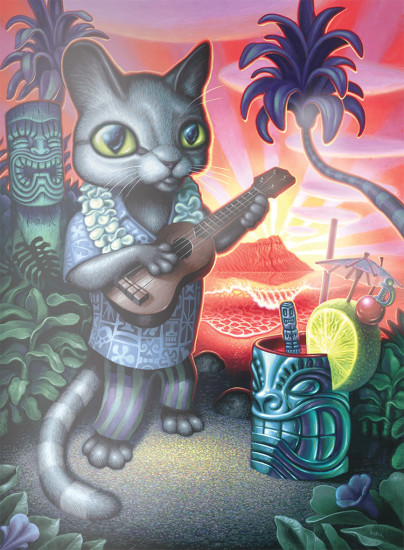
Many of Kevin’s carvings reflect the tikis found on the island and most are made of large cedar logs; the largest stands at 13 feet in height. Borrowing inspiration from carvings at Pu‘uhonua O Hōnaunau National Historical Park (Place of Refuge) and elsewhere, his pieces incorporate traditional ancient stylings with his own unique flair.
“I’ve borrowed inspiration from the Place of Refuge style, and added some of my own uniqueness,” he explains. “Occasionally, I’ll have customers who specifically want me to carve them a tiki thatʻs already carved from the Place of Refuge or the Bishop Museum and Iʻll try my best to create one. However, I prefer to do something of my own, and put my own spin on it. My work will often be standing on skulls or holding spears. I enjoy creating pieces with my own style.”
Kevin feels fortunate to be living his dream on Hawai‘i Island and creating pieces of art for people to enjoy. “Iʻm not seeking fame,” he says. “I just think itʻs really cool that people are interested in what I do, and I enjoy doing it. I like working with wood and I like being an artist. People really seem to enjoy my tiki work and that makes me happy.”
It appears the current fascination with tiki art isn’t going away anytime soon, and these three Hawai‘i Island artists are proof of its endurance. What was once retro Hawaiiana pop surrealism is now en vogue once again. ❖
For more information:
Brad Parker: tikishark.com
Jacob Medina: saatchiart.com
Kevin Murray: timbercovetiki.com
Mahalo BMW of Hawaii – Art Story Sponsor

